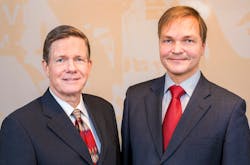IT Technology Can Strengthen Your Airport
Airports and airlines need to recognize that having robust IT systems in place at terminals can help facilitate a significant benefit that can improve the passenger experience, according to a new report from Madrid-based IT provider Amadeus. The company tapped Miami-based consultancy Frost and Sullivan to explore how airports can use the latest IT technology to strengthen their value propositions.
John Jarrell is the head of IT for Amadeus and Alexander Michael, one of the authors of the report, is director of consulting, digital transformation at Frost and Sullivan.
“We commissioned the report because we are committed to help make the airport of the future a reality,” said Jarrell. “We wanted to take a more sophisticated approach to see how modern IT can be a differentiator for airports, airlines and passengers.”
Frost & Sullivan engaged with 50 airports and interviewed 18 airports, airlines and industry experts in writing the report. “People say `if you know one airport, you know one airport. But this isn’t always true, because it can be a generalization,” said Michael.
Frost and Sullivan chose airports in order to have a fair representation from different regions across the country, said Michael. “So we balanced among hub, regional and larger airports with different shares of connecting traffic. We also looked at airports with different ownerships and different competitive profiles,” he explained. “That was complicated, but we managed to get everyone well represented and were able to draw parallels.”
So why was now the time to release this report? “We can safely say that the airline industry has been through alot and has come out on the other side,” said Jarrell “So they now have time to focus on quality and defining what that means to passengers. They are very deep in what the definition of their value proposition is, and that trend is strong.”
In many situations, airlines will only truly define strong value propositions if they cooperate with airports and other stakeholders who operate in the environment, said Jarrell.
Another point is that there’s relatively new IT technology, including products from Amadeus, on the market for airports now, said Jarrell. “Airports typically haven’t had software with cloud options in the past. So now is the time to look at how to make those investments and see how they can help a value proposition,” he said. “This is all happening right now, so this was a good time to do the study.”
The opportunity to define more comprehensive value propositions underpinned by IT, but airport IT by its nature is very complex. How to integrate the latest technology to achieve the digital transformation really depends on the airport and its needs, said Jarrell.
“There are different ways to approach this -- in the cloud or on local servers. We know airports have limited budgets, so they need to invest in IT where it can best help them,” said Jarrell. “Our paper shows that IT can be a key differentiator when it comes to a value proposition. So, for example, if you’re focused on trying to attract new traffic, having solutions that are quick and easy to be implemented can be beneficial.”
Some airlines may have excess capacity they may want to deploy if the cost to do it isn’t massive, said Michael. “If the cost to start up a route is high, it’s not worth it, and they will be less likely to experiment in the future,” he said.
There’s an airport in Florida with a major international carrier that wanted to start up a new route, said Jarrell. “Even with common-use technology, it was looking at four months to start up. But they called us and said `we want to start flying in two to three weeks,’” he said. “But because the customer was using Amadeus’ Airport Common Use Service (ACUS), which is cloud-based, we were able to get the carrier up and flying in two weeks.”
Airports have access to more modern technology options like software and cloud-based solutions that they didn’t have in the past, said Jarrell. “Take the [common-use self-service] approach. You need servers onsite and people to manage them,” he noted. “But if you put them in the cloud, you don’t need the servers and managers anymore. And it’s low cost to turn it on.”
Smaller airports with tighter budgets can now take advantage of investments they’ve already made and have a lower cost of entry, said Jarrell. “Solutions like Acus make it easier to do this. You no longer have to fund one part in advance of another.”
Even in the current cost environment, airlines are still naturally inclined to look to at reducing their costs at airports, so facility operators may have to sell the IT value proposition, which the report touches on quite well, said Jarrell. “If an airport and and airline shift their focus to on passengers, it helps take down barriers and arguments about cost,” he observed. “So if they can focus on passengers, those conversations get easier. Airports make the investments and airlines get the benefit, and sometimes that makes conversations difficult.”
The basic value of an airport is its ability to attract traffic because it is convenient to passenger journeys, said the paper. “It is still true that if there is market demand for a particular airport, airlines will compromise on all other drivers, including the IT environment.”
The common thread that unites airport operators regardless of size, geography or model is the need to modernize, attract traffic, improve operational efficiency and enhance the passenger experience, said the report. “The key component in delivering on each of these is technology, but also management vision,” it said.
Today, digital transformation is a priority for airports, as well as many other organizations. “The challenge is to defne what digital transformation means in the airport environment. So often a buzzword, or a catch-all term for everything related to technology, airports must embrace its potential to change how they do things,” said the report. “The proliferation of IT systems, and a lack of data, is endemic in many airport environments today. However, investment in airport IT offers the potential to sweep away many of the current constraints fragmented systems.”
In the end, Amadeus wants this report to advance the industry’s efforts toward the airport of the future, said Jarrell. “If we begin to see more airports embrace more modern technology to add a value proposition for a better passenger experience, that’s what we want,” he stated. “We also hope they can benefit by using our solutions. But if we didn’t want to help the industry as a whole, we could have kept it to ourselves. We just want to help the industry move in the right direction.”
Frost and Sullivan has a lot of airport customers, said Michael. “The end goal is for airports to pick this up and learn how to explain and discuss the unique benefits they deliver because of IT to help all of its stakeholders,” he said.
Airlines appreciate pre-integrated IT solutions in the cloud because they decrease complexity and increase agility, said the report. “Airport should harness the power of cloud to drive the digital transformation of the airport environment. Digital transformation will help customers trigger new revenue streams and reimagine their business.”
The most important thing that needs to change in the commercial aviation business is not information technology: the technology is already available to generate the benefits that would make an airport value proposition strong, said the report.
Pre-integrated IT solutions in the cloud should be the cornerstone of airport digital transformation, because they decrease complexity and increase agility. Airports should harness the power of the cloud to explore new business models; help customers trigger new revenue streams; and deliver a better experience for passengers. By doing so, airports will be able to turn the promise of digital transformation into real value for all.
“What must evolve is the culture of resisting change. Airlines and airports are equally grounded in tradition, but if they challenged each other to prove and enhance value, the response would be phenomenal,” it said. “By allowing airport IT departments to take a strategic role, they can create the kind of vision for IT and the wider communications and logistics infrastructure that will make the airport and its customers far more competitive.”
About the Author

